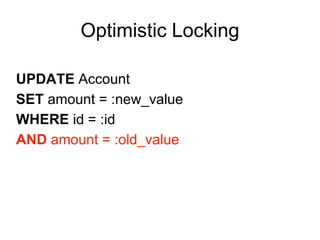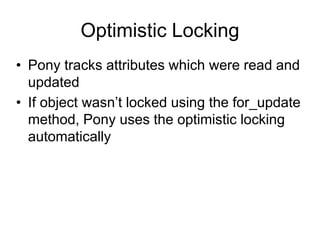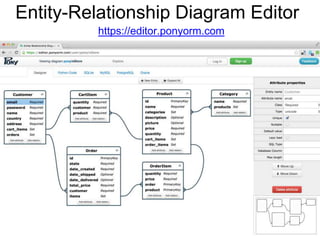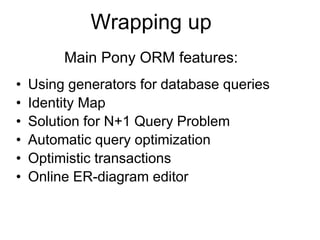How Pony ORM translates Python generators to SQL queries
- 1. Object-Relational Mapper Alexey Malashkevich @ponyorm
- 2. What makes Pony ORM different? Fast object-relational mapper which uses Python generators for writing database queries
- 3. A Python generator (p.name for p in product_list if p.price > 100)
- 4. A Python generator vs a SQL query SELECT p.name FROM Products p WHERE p.price > 100 (p.name for p in product_list if p.price > 100)
- 5. (p.name for p in product_list if p.price > 100) SELECT p.name FROM Products p WHERE p.price > 100 A Python generator vs a SQL query
- 6. (p.name for p in product_list if p.price > 100) SELECT p.name FROM Products p WHERE p.price > 100 A Python generator vs a SQL query
- 7. (p.name for p in product_list if p.price > 100) SELECT p.name FROM Products p WHERE p.price > 100 A Python generator vs a SQL query
- 8. The same query in Pony SELECT p.name FROM Products p WHERE p.price > 100 select(p.name for p in Product if p.price > 100)
- 9. • Pony ORM • Django • SQL Alchemy Query syntax comparison
- 10. Pony ORM: select(p for p in Product if p.name.startswith('A') and p.image is None or p.added.year < 2014) Query syntax comparison
- 11. Django: Product.objects.filter( Q(name__startswith='A', image__isnull=True) | Q(added__year__lt=2014)) Query syntax comparison
- 12. SQLAlchemy: session.query(Product).filter( (Product.name.startswith('A') & (Product.image == None)) | (extract('year', Product.added) < 2014)) Query syntax comparison
- 13. session.query(Product).filter( (Product.name.startswith('A') & (Product.image == None)) | (extract('year', Product.added) < 2014)) Query syntax comparison Product.objects.filter( Q(name__startswith='A', image__isnull=True) | Q(added__year__lt=2014)) select(p for p in Product if p.name.startswith('A') and p.image is None or p.added.year < 2014) Pony Django SQLAlchemy
- 14. Query translation select(p for p in Product if p.name.startswith('A') and p.image is None or p.added.year < 2014) • Translation from the bytecode is fast • The bytecode translation result is cached • The Python generator object is used as a cache key Python generator object
- 15. Building a query step by step q = select(o for o in Order if o.customer.id == some_id) q = q.filter(lambda o: o.state != 'DELIVERED') q = q.filter(lambda o: len(o.items) > 2) q = q.order_by(Order.date_created) q = q[10:20] SELECT "o"."id" FROM "Order" "o" LEFT JOIN "OrderItem" "orderitem-1" ON "o"."id" = "orderitem-1"."order" WHERE "o"."customer" = ? AND "o"."state" <> 'DELIVERED' GROUP BY "o"."id" HAVING COUNT("orderitem-1"."ROWID") > 2 ORDER BY "o"."date_created" LIMIT 10 OFFSET 10
- 16. How Pony translates generator expressions to SQL?
- 17. Python generator to SQL translation 1. Decompile bytecode and restore AST 2. Translate AST to ‘abstract SQL’ 3. Translate ‘abstract SQL’ to a specific SQL dialect
- 18. Python generator to SQL translation 1. Decompile bytecode and restore AST 2. Translate AST to ‘abstract SQL’ 3. Translate ‘abstract SQL’ to a concrete SQL dialect
- 19. Bytecode decompilation • Using the Visitor pattern • Methods of the Visitor object correspond the byte code commands • Pony keeps fragments of AST at the stack • Each method either adds a new part of AST or combines existing parts
- 20. (a + b.c) in x.y Bytecode decompilation
- 21. (a + b.c) in x.y LOAD_GLOBAL a LOAD_FAST b LOAD_ATTR c BINARY_ADD LOAD_FAST x LOAD_ATTR y COMPARE_OP in Bytecode decompilation
- 22. Bytecode decompilation (a + b.c) in x.y LOAD_GLOBAL a LOAD_FAST b LOAD_ATTR c BINARY_ADD LOAD_FAST x LOAD_ATTR y COMPARE_OP in Stack
- 23. Bytecode decompilation (a + b.c) in x.y > LOAD_GLOBAL a LOAD_FAST b LOAD_ATTR c BINARY_ADD LOAD_FAST x LOAD_ATTR y COMPARE_OP in Stack Name('a')
- 24. Bytecode decompilation (a + b.c) in x.y LOAD_GLOBAL a > LOAD_FAST b LOAD_ATTR c BINARY_ADD LOAD_FAST x LOAD_ATTR y COMPARE_OP in Stack Name('b') Name('a')
- 25. (a + b.c) in x.y LOAD_GLOBAL a LOAD_FAST b > LOAD_ATTR c BINARY_ADD LOAD_FAST x LOAD_ATTR y COMPARE_OP in Stack Getattr(Name('b'), 'c') Name('a') Bytecode decompilation
- 26. (a + b.c) in x.y LOAD_GLOBAL a LOAD_FAST b LOAD_ATTR c > BINARY_ADD LOAD_FAST x LOAD_ATTR y COMPARE_OP in Stack Add(Name('a'), Getattr(Name('b'), 'c')) Bytecode decompilation
- 27. Bytecode decompilation (a + b.c) in x.y LOAD_GLOBAL a LOAD_FAST b LOAD_ATTR c BINARY_ADD > LOAD_FAST x LOAD_ATTR y COMPARE_OP in Stack Name('x') Add(Name('a'), Getattr(Name('b'), 'c'))
- 28. Bytecode decompilation (a + b.c) in x.y LOAD_GLOBAL a LOAD_FAST b LOAD_ATTR c BINARY_ADD LOAD_FAST x > LOAD_ATTR y COMPARE_OP in Stack Getattr(Name('x'), 'y') Add(Name('a'), Getattr(Name('b'), 'c'))
- 29. Bytecode decompilation (a + b.c) in x.y LOAD_GLOBAL a LOAD_FAST b LOAD_ATTR c BINARY_ADD LOAD_FAST x LOAD_ATTR y > COMPARE_OP in Stack Compare('in', Add(…), Getattr(…))
- 30. Abstract Syntax Tree (AST) a in + .c b .y x (a + b.c) in x.y
- 31. Python generator to SQL translation 1. Decompile bytecode and restore AST 2. Translate AST to ‘abstract SQL’ 3. Translate ‘abstract SQL’ to a concrete SQL dialect
- 32. What SQL it should be translated to? a in + .c b .y x (a + b.c) in x.y
- 33. It depends on variables types! What SQL it should be translated to? (a + b.c) in x.y
- 34. • If a and c are numbers, y is a collection (? + "b"."c") IN (SELECT …) • If a and c are strings, y is a collection CONCAT(?, "b"."c") IN (SELECT …) • If a, c and y are strings “x"."y" LIKE CONCAT('%', ?, "b"."c", '%') What SQL it should be translated to? (a + b.c) in x.y
- 35. • The result of translation depends on types • If the translator analyzes node types by itself, the logic becomes too complex • Pony uses Monads to keep it simple (a + b.c) in x.y AST to SQL Translation
- 36. • Encapsulates the node translation logic • Generates the result of translation - ‘the abstract SQL’ • Can combine itself with other monads The translator delegates the logic of translation to monads A Monad
- 37. • StringAttrMonad • StringParamMonad • StringExprMonad • StringConstMonad • DatetimeAttrMonad • DatetimeParamMonad • ObjectAttrMonad • CmpMonad • etc… Each monad defines a set of allowed operations and can translate itself into a part of resulting SQL query Monad types
- 38. AST Translation • Using the Visitor pattern • Walk the tree in depth-first order • Create monads when leaving each node
- 39. (a + b.c) in x.y AST to SQL Translation in .y x + a .c b
- 40. (a + b.c) in x.y AST to SQL Translation in .y x + a .c b
- 41. (a + b.c) in x.y AST to SQL Translation in .y x + a .c b StringParam Monad
- 42. (a + b.c) in x.y AST to SQL Translation in .y x + a .c b StringParam Monad
- 43. (a + b.c) in x.y AST to SQL Translation in .y x + a .c b StringParam Monad
- 44. (a + b.c) in x.y AST to SQL Translation in .y x + a .c b StringParam Monad ObjectIter Monad
- 45. (a + b.c) in x.y AST to SQL Translation in .y x + a .c b StringParam Monad ObjectIter Monad
- 46. (a + b.c) in x.y AST to SQL Translation in .y x + a .c b StringParam Monad ObjectIter Monad StringAttr Monad
- 47. (a + b.c) in x.y AST to SQL Translation in .y x + a .c b StringParam Monad ObjectIter Monad StringAttr Monad
- 48. (a + b.c) in x.y AST to SQL Translation in .y x + a .c b StringParam Monad ObjectIter Monad StringAttr Monad StringExpr Monad
- 49. (a + b.c) in x.y AST to SQL Translation in .y x + a .c b StringParam Monad ObjectIter Monad StringAttr Monad StringExpr Monad
- 50. (a + b.c) in x.y AST to SQL Translation in .y x + a .c b StringParam Monad ObjectIter Monad StringAttr Monad StringExpr Monad
- 51. (a + b.c) in x.y AST to SQL Translation in .y x + a .c b StringParam Monad ObjectIter Monad StringAttr Monad StringExpr Monad ObjectIter Monad
- 52. (a + b.c) in x.y AST to SQL Translation in .y x + a .c b StringParam Monad ObjectIter Monad StringAttr Monad StringExpr Monad ObjectIter Monad
- 53. (a + b.c) in x.y AST to SQL Translation in .y x + a .c b StringParam Monad ObjectIter Monad StringAttr Monad StringExpr Monad ObjectIter Monad StringAttr Monad
- 54. (a + b.c) in x.y AST to SQL Translation in .y x + a .c b StringParam Monad ObjectIter Monad StringAttr Monad StringExpr Monad ObjectIter Monad StringAttr Monad
- 55. (a + b.c) in x.y AST to SQL Translation in .y x + a .c b StringParam Monad ObjectIter Monad StringAttr Monad StringExpr Monad ObjectIter Monad StringAttr Monad Cmp Monad
- 56. Abstract SQL (a + b.c) in x.y ['LIKE', ['COLUMN', 't1', 'y'], ['CONCAT', ['VALUE', '%'], ['PARAM', 'p1'], ['COLUMN', 't2', 'c'], ['VALUE', '%'] ] ] Allows to put aside the SQL dialect differences
- 57. Python generator to SQL translation 1. Decompile bytecode and restore AST 2. Translate AST to ‘abstract SQL’ 3. Translate ‘abstract SQL’ to a specific SQL dialect
- 58. Specific SQL dialects ['LIKE', ['COLUMN', 't1', 'y'], ['CONCAT', ['VALUE', '%'], ['PARAM', 'p1'], ['COLUMN', 't2', 'c'], ['VALUE', '%'] ] ] MySQL: `t1`.`y` LIKE CONCAT('%', ?, `t2`.`c`, '%') SQLite: "t1"."y" LIKE '%' || ? || "t2"."c" || '%'
- 59. Other Pony ORM features • Identity Map • Automatic query optimization • N+1 Query Problem solution • Optimistic transactions • Online ER Diagram Editor
- 60. Django ORM s1 = Student.objects.get(pk=123) print s1.name, s1.group.id s2 = Student.objects.get(pk=456) print s2.name, s2.group.id • How many SQL queries will be executed? • How many objects will be created?
- 61. Django ORM s1 = Student.objects.get(pk=123) print s1.name, s1.group.id s2 = Student.objects.get(pk=456) print s2.name, s2.group.id Student 123
- 62. Django ORM s1 = Student.objects.get(pk=123) print s1.name, s1.group.id s2 = Student.objects.get(pk=456) print s2.name, s2.group.id Student 123 Group 1
- 63. Django ORM s1 = Student.objects.get(pk=123) print s1.name, s1.group.id s2 = Student.objects.get(pk=456) print s2.name, s2.group.id Student 123 Student 456 Group 1
- 64. Django ORM s1 = Student.objects.get(pk=123) print s1.name, s1.group.id s2 = Student.objects.get(pk=456) print s2.name, s2.group.id Student 123 Student 456 Group 1 Group 1
- 65. Pony ORM s1 = Student[123] print s1.name, s1.group.id s2 = Student[456] print s2.name, s2.group.id
- 66. Pony ORM – seeds, IdentityMap s1 = Student[123] print s1.name, s1.group.id s2 = Student[456] print s2.name, s2.group.id Student 123 Group 1
- 67. Pony ORM – seeds, IdentityMap s1 = Student[123] print s1.name, s1.group.id s2 = Student[456] print s2.name, s2.group.id Student 123 Group 1 seed
- 68. Pony ORM – seeds, IdentityMap s1 = Student[123] print s1.name, s1.group.id s2 = Student[456] print s2.name, s2.group.id Student 123 Group 1 seed
- 69. Pony ORM – seeds, IdentityMap s1 = Student[123] print s1.name, s1.group.id s2 = Student[456] print s2.name, s2.group.id Student 123 Student 456 Group 1 seed
- 70. Pony ORM – seeds, IdentityMap s1 = Student[123] print s1.name, s1.group.id s2 = Student[456] print s2.name, s2.group.id Student 123 Student 456 Group 1 seed
- 71. Solution for the N+1 Query Problem orders = select(o for o in Order if o.total_price > 1000) .order_by(desc(Order.id)).page(1, pagesize=5) for o in orders: print o.total_price, o.customer.name 1 SELECT o.id, o.total_price, o.customer_id,... FROM "Order" o WHERE o.total_price > 1000 ORDER BY o.id DESC LIMIT 5
- 72. Order 1 Order 3 Order 4 Order 7 Order 9 Customer 1 Customer 4 Customer 7 Solution for the N+1 Query Problem
- 73. Order 1 Order 3 Order 4 Order 7 Order 9 Customer 1 Customer 4 Customer 7 Solution for the N+1 Query Problem One SQL query
- 74. Solution for the N+1 Query Problem 1 1 SELECT c.id, c.name, … FROM “Customer” c WHERE c.id IN (?, ?, ?) orders = select(o for o in Order if o.total_price > 1000) .order_by(desc(Order.id)).page(1, pagesize=5) for o in orders: print o.total_price, o.customer.name SELECT o.id, o.total_price, o.customer_id,... FROM "Order" o WHERE o.total_price > 1000 ORDER BY o.id DESC LIMIT 5
- 75. Automatic query optimization select(c for c in Customer if sum(c.orders.total_price) > 1000) SELECT "c"."id", "c"."email", "c"."password", "c"."name", "c"."country", "c"."address" FROM "Customer" "c" WHERE ( SELECT coalesce(SUM("order-1"."total_price"), 0) FROM "Order" "order-1" WHERE "c"."id" = "order-1"."customer" ) > 1000 SELECT "c"."id" FROM "Customer" "c" LEFT JOIN "Order" "order-1" ON "c"."id" = "order-1"."customer" GROUP BY "c"."id" HAVING coalesce(SUM("order-1"."total_price"), 0) > 1000
- 76. Transactions def transfer_money(id1, id2, amount): account1 = Account.objects.get(pk=id1) if account1.amount < amount: raise ValueError('Not enough funds!') account2 = Account.object.get(pk=id2) account1.amount -= amount account1.save() account2.amount += amount account2.save() Django ORM
- 77. @transaction.atomic def transfer_money(id1, id2, amount): account1 = Account.objects.get(pk=id1) if account1.amount < amount: raise ValueError('Not enough funds!') account2 = Account.object.get(pk=id2) account1.amount -= amount account1.save() account2.amount += amount account2.save() Transactions Django ORM
- 78. @transaction.atomic def transfer_money(id1, id2, amount): account1 = Account.objects .select_for_update.get(pk=id1) if account1.amount < amount: raise ValueError('Not enough funds!') account2 = Account.objects .select_for_update.get(pk=id2) account1.amount -= amount account1.save() account2.amount += amount account2.save() Transactions Django ORM
- 79. @db_session def transfer_money(id1, id2, amount): account1 = Account[id1] if account1.amount < amount: raise ValueError('Not enough funds!') account1.amount -= amount Account[id2].amount += amount Transactions Pony ORM
- 80. db_session • Pony tracks which objects where changed • No need to call save() • Pony saves all updated objects in a single transaction automatically on leaving the db_session scope Transactions
- 81. UPDATE Account SET amount = :new_value WHERE id = :id AND amount = :old_value Optimistic Locking
- 82. Optimistic Locking • Pony tracks attributes which were read and updated • If object wasn’t locked using the for_update method, Pony uses the optimistic locking automatically
- 86. Main Pony ORM features: • Using generators for database queries • Identity Map • Solution for N+1 Query Problem • Automatic query optimization • Optimistic transactions • Online ER-diagram editor Wrapping up
- 87. • Python 3 • Microsoft SQL Server support • Improved documentation • Migrations • Ansync queries Pony roadmap
- 88. • Site ponyorm.com • Twitter @ponyorm • Github github.com/ponyorm/pony • ER-Diagram editor editor.ponyorm.com • Installation: pip install pony Thank you! Pony ORM




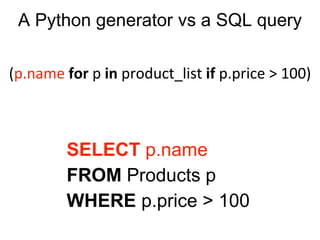





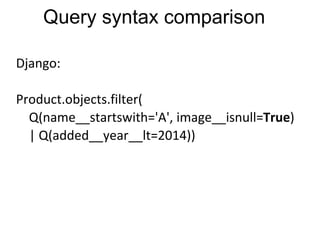


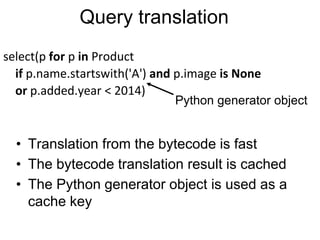
![Building a query step by step
q = select(o for o in Order if o.customer.id == some_id)
q = q.filter(lambda o: o.state != 'DELIVERED')
q = q.filter(lambda o: len(o.items) > 2)
q = q.order_by(Order.date_created)
q = q[10:20]
SELECT "o"."id"
FROM "Order" "o"
LEFT JOIN "OrderItem" "orderitem-1"
ON "o"."id" = "orderitem-1"."order"
WHERE "o"."customer" = ?
AND "o"."state" <> 'DELIVERED'
GROUP BY "o"."id"
HAVING COUNT("orderitem-1"."ROWID") > 2
ORDER BY "o"."date_created"
LIMIT 10 OFFSET 10](https://image.slidesharecdn.com/ponyorm-ep-2014slideshare-140728033726-phpapp02/85/How-Pony-ORM-translates-Python-generators-to-SQL-queries-15-320.jpg)




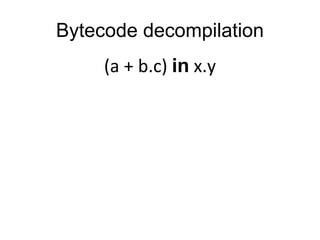







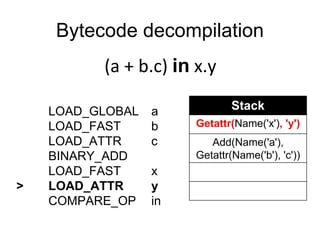
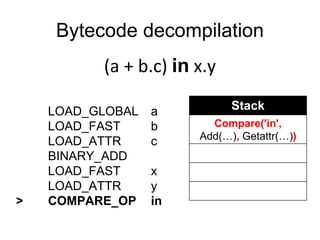



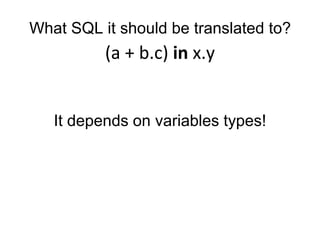
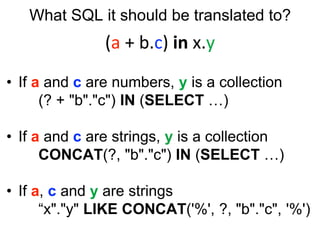


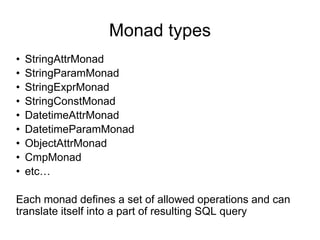







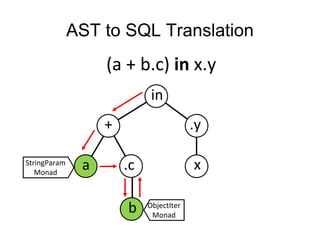









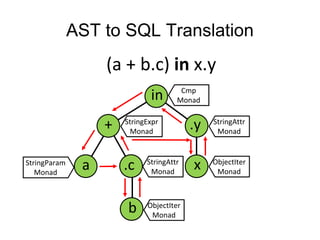
![Abstract SQL
(a + b.c) in x.y
['LIKE', ['COLUMN', 't1', 'y'],
['CONCAT',
['VALUE', '%'], ['PARAM', 'p1'],
['COLUMN', 't2', 'c'], ['VALUE', '%']
]
]
Allows to put aside the SQL dialect differences](https://image.slidesharecdn.com/ponyorm-ep-2014slideshare-140728033726-phpapp02/85/How-Pony-ORM-translates-Python-generators-to-SQL-queries-56-320.jpg)
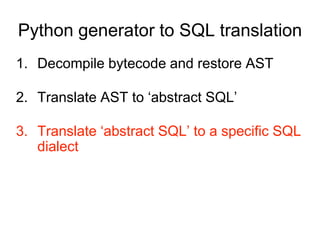
![Specific SQL dialects
['LIKE', ['COLUMN', 't1', 'y'],
['CONCAT',
['VALUE', '%'], ['PARAM', 'p1'],
['COLUMN', 't2', 'c'], ['VALUE', '%']
]
]
MySQL:
`t1`.`y` LIKE CONCAT('%', ?, `t2`.`c`, '%')
SQLite:
"t1"."y" LIKE '%' || ? || "t2"."c" || '%'](https://image.slidesharecdn.com/ponyorm-ep-2014slideshare-140728033726-phpapp02/85/How-Pony-ORM-translates-Python-generators-to-SQL-queries-58-320.jpg)






![Pony ORM
s1 = Student[123]
print s1.name, s1.group.id
s2 = Student[456]
print s2.name, s2.group.id](https://image.slidesharecdn.com/ponyorm-ep-2014slideshare-140728033726-phpapp02/85/How-Pony-ORM-translates-Python-generators-to-SQL-queries-65-320.jpg)
![Pony ORM – seeds, IdentityMap
s1 = Student[123]
print s1.name, s1.group.id
s2 = Student[456]
print s2.name, s2.group.id
Student 123
Group 1](https://image.slidesharecdn.com/ponyorm-ep-2014slideshare-140728033726-phpapp02/85/How-Pony-ORM-translates-Python-generators-to-SQL-queries-66-320.jpg)
![Pony ORM – seeds, IdentityMap
s1 = Student[123]
print s1.name, s1.group.id
s2 = Student[456]
print s2.name, s2.group.id
Student 123
Group 1
seed](https://image.slidesharecdn.com/ponyorm-ep-2014slideshare-140728033726-phpapp02/85/How-Pony-ORM-translates-Python-generators-to-SQL-queries-67-320.jpg)
![Pony ORM – seeds, IdentityMap
s1 = Student[123]
print s1.name, s1.group.id
s2 = Student[456]
print s2.name, s2.group.id
Student 123
Group 1
seed](https://image.slidesharecdn.com/ponyorm-ep-2014slideshare-140728033726-phpapp02/85/How-Pony-ORM-translates-Python-generators-to-SQL-queries-68-320.jpg)
![Pony ORM – seeds, IdentityMap
s1 = Student[123]
print s1.name, s1.group.id
s2 = Student[456]
print s2.name, s2.group.id
Student 123
Student 456
Group 1
seed](https://image.slidesharecdn.com/ponyorm-ep-2014slideshare-140728033726-phpapp02/85/How-Pony-ORM-translates-Python-generators-to-SQL-queries-69-320.jpg)
![Pony ORM – seeds, IdentityMap
s1 = Student[123]
print s1.name, s1.group.id
s2 = Student[456]
print s2.name, s2.group.id
Student 123
Student 456
Group 1
seed](https://image.slidesharecdn.com/ponyorm-ep-2014slideshare-140728033726-phpapp02/85/How-Pony-ORM-translates-Python-generators-to-SQL-queries-70-320.jpg)








![@db_session
def transfer_money(id1, id2, amount):
account1 = Account[id1]
if account1.amount < amount:
raise ValueError('Not enough funds!')
account1.amount -= amount
Account[id2].amount += amount
Transactions
Pony ORM](https://image.slidesharecdn.com/ponyorm-ep-2014slideshare-140728033726-phpapp02/85/How-Pony-ORM-translates-Python-generators-to-SQL-queries-79-320.jpg)

